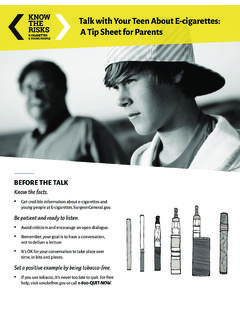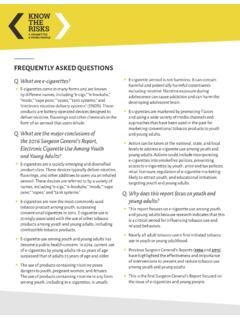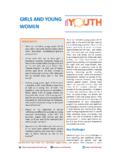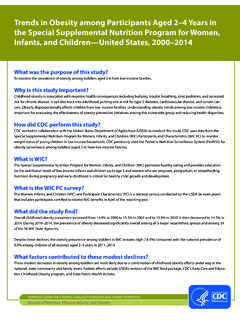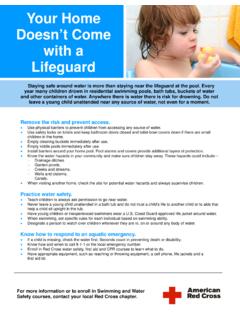Transcription of A Report of the Surgeon General
1 E-Cigarette Use among Youth and young AdultsA Report of the Surgeon GeneralFact SheetThis Surgeon General s Report comprehensively reviews the public health issue of e-cigarettes and their impact on youth and young adults. Studies highlighted in the Report cover young adolescents (11-14 years of age); adolescents (15-17 years of age); and/or young adults (18-25 years of age). Scientific evidence contained in this Report supports the following facts:E-cigarettes are a rapidly emerging and diversified product class. These devices typically deliver nicotine, flavorings, and other additives to users via an inhaled aerosol. These devices are referred to by a variety of names, including e-cigs, e-hookahs, mods, vape pens, vapes, and tank systems. E-cigarettes are battery-powered devices that heat a liquid into an aerosol that the user inhales. The liquid usually has nicotine, which comes from tobacco; flavoring; and other additives. E-cigarette products can also be used as a delivery system for marijuana and other illicit are now the most commonly used tobacco product among youth, surpassing conventional cigarettes in 2014.
2 E-cigarette use is strongly associated with the use of other tobacco products among youth and young adults, including cigarettes and other burned tobacco products. In 2015, more than 3 million youth in middle and high school, including about 1 of every 6 high school students, used e-cigarettes in the past month. More than a quarter of youth in middle and high school have tried e-cigarettes. among high school students, e-cigarette use is higher among males, whites, and Hispanics than among females and African-Americans. There is a strong association between the use of e-cigarettes, cigarettes, and the use of other burned tobacco products by young people. In 2015, for example, nearly 6 of 10 high school cigarette smokers also used e-cigarettes. Research has found that youth who use a tobacco product, such as e-cigarettes, are more likely to go on to use other tobacco products like use among youth and young adults has become a public health concern. In 2014, current use of e-cigarettes by young adults 18-24 years of age surpassed that of adults 25 years of age and older.
3 among young adults 18-24 years of age, e-cigarette use more than doubled from 2013 to 2014. As of 2014, more than one-third of young adults had tried e-cigarettes. The most recent data available show that the prevalence of past 30-day use of e-cigarettes was among young adults (2014) and among high school students (2015). The most recent data available show that the prevalence of past 30-day use of e-cigarettes is similar among middle school students ( ) and adults 25 years of age and older ( ). among young adults, e-cigarette use is higher among males, whites and Hispanics, and those with less education. The use of products containing nicotine poses dangers to youth, pregnant women, and fetuses. The use of products containing nicotine in any form among youth, including in e-cigarettes, is unsafe. Many e-cigarettes contain nicotine, which is highly addictive. The brain is the last organ in the human body to develop fully. Brain development continues until the early to mid-20s.
4 Nicotine exposure during periods of significant brain development, such as adolescence, can disrupt the growth of brain circuits that control attention, learning, and susceptibility to addiction. The effects of nicotine exposure during youth and young adulthood can be long-lasting and can include lower impulse control and mood disorders. The nicotine in e-cigarettes and other tobacco products can prime young brains for addiction to other drugs, such as cocaine and methamphetamine. Department of Health and Human ServicesFact sheet (continued) Nicotine can cross the placenta and affect fetal and postnatal development. Nicotine exposure during pregnancy can result in multiple adverse consequences, including sudden infant death syndrome (SIDS). Ingestion of e-cigarette liquids containing nicotine can cause acute toxicity and possible death if the contents of refill cartridges or bottles containing nicotine are aerosol is not harmless. It can contain harmful and potentially harmful constituents including nicotine.
5 Nicotine exposure during adolescence can cause addiction and can harm the developing adolescent brain. The constituents of e-cigarette liquids can include solvents, flavorants, and toxicants. The aerosol created by e-cigarettes can contain ingredients that are harmful and potentially harmful to the public s health, including: nicotine; ultrafine particles; flavorings such as diacetyl, a chemical linked to serious lung disease; volatile organic compounds such as benzene, which is found in car exhaust; and heavy metals, such as nickel, tin, and are marketed by promoting flavors and using a wide variety of media channels and approaches that have been used in the past for marketing conventional tobacco products to youth and young adults. E-cigarettes are an estimated $ billion business in the United States. In 2014, e-cigarette manufacturers spent $125 million advertising their products in the In 2014, more than 7 of 10 middle and high school students said they had seen e-cigarette advertising.
6 Retail stores were the most frequent source of this advertising, followed by the internet, TV and movies, and magazines and newspapers. The 2012 Surgeon General s Report on tobacco use among youth and young adults found that tobacco product advertising causes young people to start using tobacco products. Much of today s e-cigarette advertising uses approaches and themes similar to those that were used to promote conventional tobacco products. E-cigarettes are available in a wide variety of flavors, including many that are especially appealing to youth. More than 85% of e-cigarette users ages 12-17 use flavored e-cigarettes, and flavors are the leading reason for youth use. More than 9 of 10 young adult e-cigarette users said they use e-cigarettes flavored to taste like menthol, alcohol, fruit, chocolate, or other can be taken at the national, state, local, tribal and territorial levels to address e-cigarette use among youth and young adults. Actions could include incorporating e-cigarettes into smokefree policies, preventing access to e-cigarettes by youth, price and tax policies, retail licensure, regulation of e-cigarette marketing likely to attract youth, and educational initiatives targeting youth and young adults.
7 The Food and Drug Administration (FDA) now regulates the manufacturing, importing, packaging, labeling, advertising, promotion, sale, and distribution of e-cigarettes. In August 2016, FDA began enforcing a ban on vending machine sales unless in adult-only facilities and a ban on free samples and sales to minors. Parents, teachers, health care providers, and others who influence youth and young adults can advise and inform them of the dangers of nicotine; discourage youth tobacco use in any form, including e-cigarettes; and set a positive example by being tobacco-free : Department of Health and Human Services. E-Cigarette Use among Youth and young Adults: A Report of the Surgeon General Executive Summary. Atlanta, GA: Department of Health and Human Services, Centers for Disease Control and Prevention, National Center for Chronic Disease Prevention and Health Promotion, Office on Smoking and Health, 2016. Website: Department of Health and Human Services

